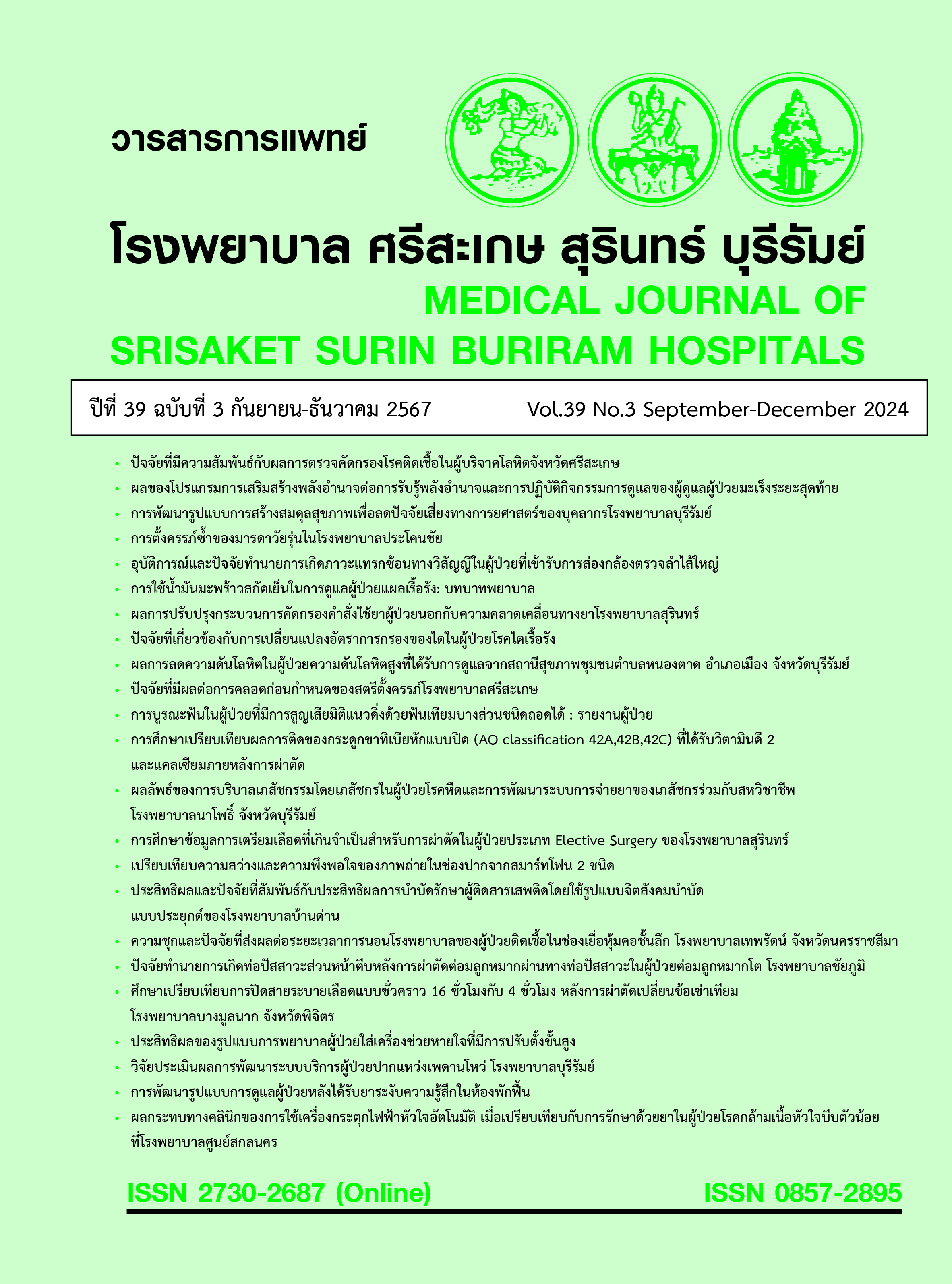Predictors of Anterior Urethral Stricture Following Transurethral Resection of Prostate (TURP) in Chaiyaphum Hospital
Main Article Content
Abstract
Background: Anterior urethral stricture is the cause from transurethral resection of prostate (TURP)and leads to lower urinary tract obstruction. Prevention of risk factors can reduce anterior urethral stricture.
Objective: To study predictive factors associated anterior urethral stricture in post operative TURP in Chaiyaphum hospital.
Methods: The retrospective cohort study with 251 the reviewed medical records those patients more than 50 years old who had post TURP and between 1st January 2017 to 31th December 2023 and follow-up period 6 month who have LUTS signs, 236 case were group1(post TURP with nonanterior urethral stricture) and 15 case (post TURP with anterior urethral stricture). The general data were analyzed using descriptive statistics, prognostic factors were used univariate and multivariate analysis (p-value<0.05).
Results: There were 251 post TURP patients included to study. Group 1 mean age 68.7±4.5 years, mean IPSS 24.2±3.9, mean operation time 52.9±13.9 min, mean resection prostate volume 15.1±3.8 gms and re TURP 1.3%. Group 2 The 15 bulbar urethral stricture patients were received urethral dilatation treatment, mean age 69.8±6.7 years, mean IPSS 25.9±4.0, mean operation time 62.7±16.1 min, mean resection prostate volume 15.6±2.5 gms and re TURP 83.7%. Predictive factors associated urethral stricture were UTI (Adj OR 18.0; 95% CI, 2.3-138.2), operation time (Adj OR 1.1; 95% CI, 1.0-1.1), re TURP (Adj OR 0.0; 95% CI, 0.0-0.2) and Urine retention with re-catheter (Adj OR 0.0; 95% CI, 0.0-0.2).
Conclusion: The factors predicting include: UTI, operation time 46.6-78.8minutes, Re-TURP and retention with re-catheter. Therefore, you must have attention be careful about these factors and reduced risks for anterior urethral stricture.
Article Details

This work is licensed under a Creative Commons Attribution-NonCommercial-NoDerivatives 4.0 International License.
References
Yoo TK, Cho HJ. Benign prostatic hyperplasia: from bench to clinic. Korean J Urol. 2012;53(3):139-48. doi: 10.4111/kju.2012.53.3.139.
Roehrborn CG. Benign prostatic hyperplasia: an overview. Rev Urol. 2005;7 Suppl 9(Suppl 9):S3-S14. PMID: 16985902.
Egan KB. The Epidemiology of Benign Prostatic Hyperplasia Associated with Lower Urinary Tract Symptoms: Prevalence and Incident Rates. Urol Clin North Am. 2016;43(3):289-97. doi: 10.1016/j.ucl.2016.04.001.
Perchon LF, Pintarelli VL, Bezerra E, Thiel M, Dambros M. Quality of life in elderly men with aging symptoms and lower urinary tract symptoms (LUTS). Neurourol Urodyn. 2011;30(4):515-9. doi: 10.1002/nau.21008.
Roehrborn CG. Pathology of benign prostatic hyperplasia. Int J Impot Res. 2008;20(Suppl 3):S11-8. doi: 10.1038/ijir.2008.55.
Settawanit E, Saila N, Attanath S. Correlation evaluation of the international prostate symptom score (IPSS), visual prostate symptom score (VPSS), and modified visual prostate symptom score (mVPSS) in Thai males with benign prostatic hyperplasia. Insight Urol. 2020;41(2):17-28.
McVary KT, Roehrborn CG, Avins AL, Barry MJ, Bruskewitz RC, Donnell RF, et al. Update on AUA guideline on the management of benign prostatic hyperplasia. J Urol. 2011;185(5):1793-803. doi: 10.1016/j.juro.2011.01.074.
Yip SK, Chan NH, Chiu P, Lee KW, Ng CF. A randomized controlled trial comparing the efficacy of hybrid bipolar transurethral vaporization and resection of the prostate with bipolar transurethral resection of the prostate. J Endourol. 2011;25(12):1889-94. doi: 10.1089/end.2011.0269.
Rassweiler J, Teber D, Kuntz R, Hofmann R. Complications of transurethral resection of the prostate (TURP)--incidence, management, and prevention. Eur Urol. 2006;50(5):969-79. doi: 10.1016/j.eururo.2005.12.042.
Latini JM, McAninch JW, Brandes SB, Chung JY, Rosenstein D. SIU/ICUD Consultation On Urethral Strictures: Epidemiology, etiology, anatomy, and nomenclature of urethral stenoses, strictures, and pelvic fracture urethral disruption injuries. Urology. 2014;83(3 Suppl):S1-7. doi: 10.1016/j.urology.2013.09.009.
Hampson LA, McAninch JW, Breyer BN. Male urethral strictures and their management. Nat Rev Urol. 2014;11(1):43-50. doi: 10.1038/nrurol.2013.275.
Stein MJ, DeSouza RA. Anterior urethral stricture review. Transl Androl Urol. 2013;2(1):32-8. doi: 10.3978/j.issn.2223-4683.2012.11.05.
Wessells H, Angermeier KW, Elliott S, Gonzalez CM, Kodama R, Peterson AC, et al. Male Urethral Stricture: American Urological Association Guideline. J Urol. 2017;197(1):182-90. doi: 10.1016/j.juro.2016.07.087.
กลุ่มงานศัลยกรรม โรงพยาบาลชัยภูมิ. สถิติผู้ใช้บริการ ปี 2560-2566. ชัยภูมิ: กลุ่มงานศัลยกรรม โรงพยาบาลชัยภูมิ; 2566.
Das Bhagia S, Mahmud SM, El Khalid S. Is it necessary to remove foleys catheter late after transurethral prostatectomy in patients who presented with acute urinary retention secondary to benign prostatic hyperplasia? J Pak Med Assoc. 2010;60(9):739-41. PMID: 21381581.
Tao H, Jiang YY, Jun Q, Ding X, Jian DL, Jie D, et al. Analysis of risk factors leading to postoperative urethral stricture and bladder neck contracture following transurethral resection of prostate. Int Braz J Urol. 2016;42(2):302-11. doi: 10.1590/S1677-5538.IBJU.2014.0500.
Mundy AR, Andrich DE. Urethral strictures. BJU Int. 2011;107(1):6-26. doi: 10.1111/j.1464-410X.2010.09800.x.
อนวัช วรรธนะมณีกุล. ปัจจัยที่มีอิทธิพลต่อการบาดเจ็บชั่วคราวของเส้นประสาท Recurrent Laryngeal หลังผ่าตัดไทรอยด์. ไทรอยด์. วารสารการแพทย์โรงพยาบาลศรีสะเกษ สุรินทร์ บุรีรัมย์. 2563;35(1):141-55.
Kelsey L, Fleiss K, Fleiss P. Methods in observational epidemiology 2nd edition, statistical methods for rates and proportion, formulas 3.18 and 19; 2010. Available from: http://www.openepi.com/SampleSize/SSCohort.htm. [Cited 2015 Nov 27].
Komura K, Inamoto T, Takai T, Uchimoto T, Saito K, Tanda N, et al. Incidence of urethral stricture after bipolar transurethral resection of the prostate using TURis: results from a randomised trial. BJU Int. 2015;115(4):644-52. doi: 10.1111/bju.12831.
Sonmez G, Topaloglu US, Keske M, Demirtas A. Efficacy of Alfuzosin in Male Patients with Moderate Lower Urinary Tract Symptoms: Is Metabolic Syndrome a Factor Affecting the Outcome? Urol J. 2020;17(5):517-21. doi: 10.22037/uj.v16i7.6204.
Lumen N, Hoebeke P, Willemsen P, De Troyer B, Pieters R, Oosterlinck W. Etiology of urethral stricture disease in the 21st century. J Urol. 2009;182(3):983-7. doi: 10.1016/j.juro.2009.05.023.
Punsanguansuk D, Choonhaklai V. Recurrent rate of urethral stricture after urethroplasty in Rajavithi Hospital TJU. 2018;39(1):1-8.
Kashefi C, Messer K, Barden R, Sexton C, Parsons JK. Incidence and prevention of iatrogenic urethral injuries. J Urol. 2008;179(6):2254-7. doi: 10.1016/j.juro.2008.01.108.

